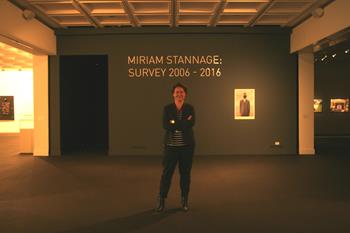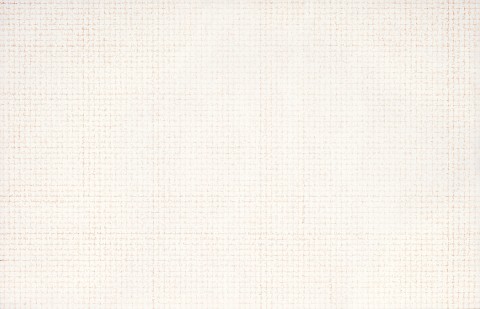NEWS FROM DUBLIN, 1974 (also known as 'IRISH SONG')
MIRIAM STANNAGE
felt-tipped pen and lead pencil on synthetic polymer on canvas
148.0 x 229.0 cm
signed and dated on upper right edge: Stannage '74
signed and dated verso: STANNAGE 74
inscribed with title verso: “NEWS FROM DUBLIN”
Tolarno Galleries, Melbourne
The National Australia Bank Art Collection, acquired from the above in 1975 (label attached verso)
Miriam Stannage, Tolarno Galleries, Melbourne, 1975
The Seventies: Australian Paintings and Tapestries from the Collection of National Australia Bank, National Gallery of Victoria, Melbourne, 15 October – 28 November 1982 (as ‘Irish Song’)
The Seventies: Australian Paintings and Tapestries from the Collection of National Australia Bank, Geelong Art Gallery, Victoria, 30 April - 29 May 1988
Miriam Stannage: Perception 1969 – 1989, Art Gallery of Western Australia, Perth, 20 April – 25 May 1989, cat. 12 (as ‘Irish Song’)
The Seventies: Contemporary Australian Paintings from the National Australia Bank Collection, organised by Regional Galleries Association of New South Wales, New South Wales, cat. 25; and touring, Tamworth City Art Gallery, New South Wales, 24 May – 24 June 1990; Dubbo Regional Art Gallery, New South Wales, 11 July – 6 August 1990; Wagga Wagga City Art Gallery, New South Wales, 17 August – 10 September 1990; Moree Plains Regional Gallery, New South Wales, 3 October – 31 October 1990
Lindsay, R., The Seventies: Australian Paintings and Tapestries from the Collection of National Australia Bank, The National Bank of Australasia, Melbourne, 1982, pl. 85, p. 98 (illus., as ‘Irish Song’)
Millar, R., 'A Confident 10 Years', The Herald, Melbourne, 21 October 1982, p. 37
Frangos, S. and Moore, M., Miriam Stannage: Perception 1969 – 1989, Art Gallery of Western Australia, Perth, 1989, pp. 35 (illus.), 57 (as ‘Irish Song’)
Fenner, F., 'The Good Life: Paintings lost in the 70s', Tamworth Daily Leader, New South Wales, 1 June 1990
Gallagher, G., and Stannage, M., ‘Miriam Stannage interview, 18 December 2014’, UWA Historical Society: UWA Histories, Perth [https://oralhistories.arts.uwa.edu.au/items/show/88] (accessed 12/1/22)
STANNAGE.jpg

There is a well-known roll call of modern and contemporary Western Australian artists but one of its most accomplished is perhaps less familiar outside her native state. Emerging to prominence in the 1970s, Miriam Stannage ranks as one of the most thoughtful and experimental artists of her generation. ‘…Western Australian artists at first abstained when internationalism inspired their counterparts in the eastern states to adopt the severe and simple language of minimal art.’1 Stannage was perhaps the least reserved when it came to contemporary trends – including conceptualism and minimalism – and what might be useful in her intellectually curious mind and across her diverse application of media.
Stannage’s career is one of constant conceptual inventiveness – timidness and equivocation were never part of her temperament. She began as a painter and early in her career was rewarded for it.2 Her later flat-coloured abstractions hold a variety of interests from a neo-Pop effect to Op and playing with Colourfield formalism. When she was included in the Biennale of Sydney in 1982 and Perspecta, Art Gallery of New South Wales, in 1983 she was regarded as a remarkable photographer and her images remain admired for their idiosyncratic character – often metaphorical, sometimes dark and many imbued with neo-Dada wit.
In the seventies her use of the grid and text drew critical interest.3 As an artist for whom serialisation and formatted repetition were frequent ways in which she dealt with an idea and her subject, the grid in various guises became a familiar compositional system. Stannage belonged to a generation of Australian artists for whom text was crucial throughout their careers. Ian Burn, Robert MacPherson and Madonna Staunton were each born in or a year or so either side of 1939. Their use of text arises from quite separate intellectual intentions. From Stanton’s collaged letter and word ensembles in the seventies, to Burn’s work back in Australia after his preoccupation with Art & Language, and McPherson’s sign and hoarding paintings, each has reminded us of the use of language as holding a purpose and aesthetic that is important to recent decades of Australian art.
Such context helps us place the importance of News from Dublin at a critical time in the seventies. It also offers a specific account of her broader artistic inclinations and personal humanitarian instincts4; as she reflected, ‘… most of my work appears to … be concerned with the passage of time and the concerns repeatedly occurring are religion, nature, war, sex and sexuality and art.’5 News from Dublin is a large and beguiling object: it must first interest us as a work of art before we are drawn to the meaning, style and deliberate formatting of the text. This double responsibility is deftly handled. The discreet pencilled grid and the muted softness seem to evoke the same kind of surface manner of Agnes Martin’s soft geometric paintings. But News from Dublin represents a hideous violence and it is not imaginary. Each line is a verbatim account taken from some of the Republic of Ireland and Northern Ireland’s worst episodes. There is no hyperbole: they are almost deadpan matter-of-fact descriptions of sectarian human conduct at its indiscriminate awfulness. The work can be dated with precision: Another woman was trying to move her legs. Her foot had been blown off. Another woman was rushing with her child to a police car and I saw another man being carried away by his arms and legs with blood pouring from his face and chest. And on it goes. The same account repeated horizontally and vertically: the Dublin and Monaghan bombings of 17 May 1974.6
News from Dublin is pictorially interesting and gripping with its use of language. When we realise what we are reading it has the personality of a strange and beautiful memorial expressed within an astonishing work of art.
1. Stringer, J., Material and Perfection, Minimal Art & Its Aftermath; selected works from the Kerry Stokes Collection, Lawrence Wilson Art Gallery, University of Western Australia, Perth, 1998, p.32
2. Stannage was awarded the Albany Art Prize in 1970. Bernard Smith was its judge and nominated her for a Power Institute Residency, Cité Internationale des Arts, Paris, which she took up in 1971
3. The Grid Show/A Structured Space, Ewing Gallery, Melbourne University, 1975.
4. For a fuller personal account see: Kinsella, L., Tribute – Miriam Stannage 1939 – 2016, Art Monthly Australia, Summer 2016 – 17, p.78
5. Stannage cited in Ennis, H., Miriam Stannage, Perception 1969 – 1989, Art Gallery of Western Australia, Perth, 1989, p. 17
6. Wikipedia records 1974 and each attack. Another detailed record of the conflict is CAIN Archive [online], Ulster University, Northern Ireland.
DOUG HALL AM
